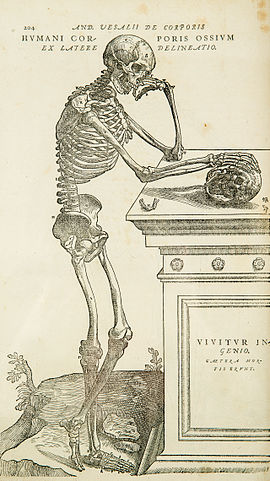Anatomy (nonfiction): Difference between revisions
(Created page with "'''Anatomy''' is the branch of biology concerned with the study of the structure of organisms and their parts. == Description == Anatomy is inherently tied to embryology, co...") |
No edit summary |
||
| Line 1: | Line 1: | ||
'''Anatomy''' is the branch of biology concerned with the study of the structure of organisms and their parts. | [[File:Humani_Corporis_Ossium_Vesalius.jpg|Detail from Andreas Vesalius's ''De humani corporis fabrica'' 16th century, marking the rebirth of anatomy.]]'''Anatomy''' is the branch of biology concerned with the study of the structure of organisms and their parts. | ||
Anatomy is inherently tied to embryology, comparative anatomy, evolutionary biology, and phylogeny, as these are the processes by which anatomy is generated over immediate (embryology) and long (evolution) timescales. | Anatomy is inherently tied to embryology, comparative anatomy, evolutionary biology, and phylogeny, as these are the processes by which anatomy is generated over immediate (embryology) and long (evolution) timescales. | ||
Human anatomy is one of the basic essential sciences of medicine. | Human anatomy is one of the basic essential sciences of medicine. | ||
Macroscopic anatomy, or gross anatomy, is the examination of an animal's body parts using unaided eyesight. | Macroscopic anatomy, or gross anatomy, is the examination of an animal's body parts using unaided eyesight. | ||
Microscopic anatomy involves the use of optical instruments in the study of the tissues of various structures, known as histology, and also in the study of cells. | |||
The history of anatomy is characterized by a progressive understanding of the functions of the organs and structures of the human body. | The history of anatomy is characterized by a progressive understanding of the functions of the organs and structures of the human body. | ||
== In the News == | |||
<gallery mode="traditional"> | |||
</gallery> | |||
== Fiction cross-reference == | |||
* [[Anna Morandi Manzolini]] | |||
== Nonfiction cross-reference == | == Nonfiction cross-reference == | ||
| Line 24: | Line 25: | ||
* [[Anna Morandi Manzolini (nonfiction)]] | * [[Anna Morandi Manzolini (nonfiction)]] | ||
External links: | |||
* [https://en.wikipedia.org/wiki/Anatomy Anatomy] @ Wikipedia | * [https://en.wikipedia.org/wiki/Anatomy Anatomy] @ Wikipedia | ||
* [https://en.wikipedia.org/wiki/History_of_anatomy History of anatomy] @ Wikipedia | |||
[[Category:Anatomists]] | [[Category:Anatomists]] | ||
[[Category:Science]] | [[Category:Science]] | ||
Revision as of 06:51, 24 June 2016
 Anatomy is the branch of biology concerned with the study of the structure of organisms and their parts.
Anatomy is the branch of biology concerned with the study of the structure of organisms and their parts.
Anatomy is inherently tied to embryology, comparative anatomy, evolutionary biology, and phylogeny, as these are the processes by which anatomy is generated over immediate (embryology) and long (evolution) timescales.
Human anatomy is one of the basic essential sciences of medicine.
Macroscopic anatomy, or gross anatomy, is the examination of an animal's body parts using unaided eyesight.
Microscopic anatomy involves the use of optical instruments in the study of the tissues of various structures, known as histology, and also in the study of cells.
The history of anatomy is characterized by a progressive understanding of the functions of the organs and structures of the human body.
In the News
Fiction cross-reference
Nonfiction cross-reference
External links:
- Anatomy @ Wikipedia
- History of anatomy @ Wikipedia